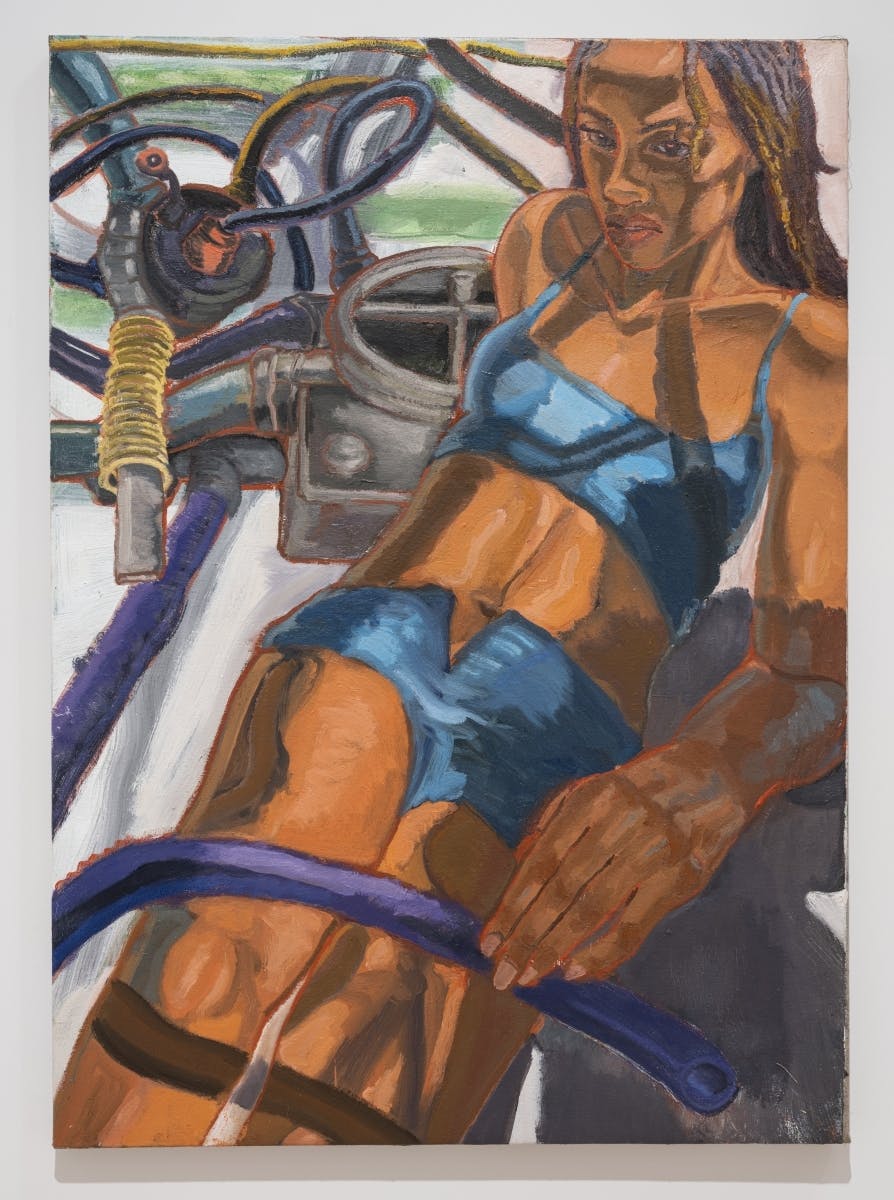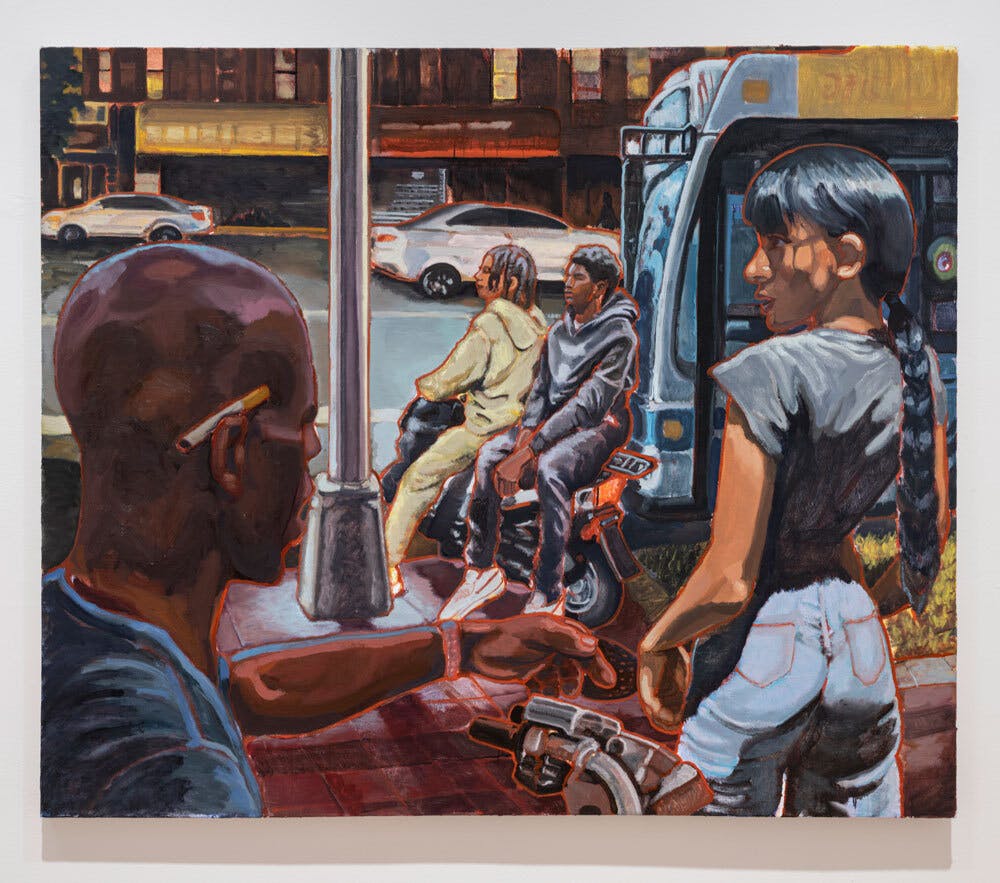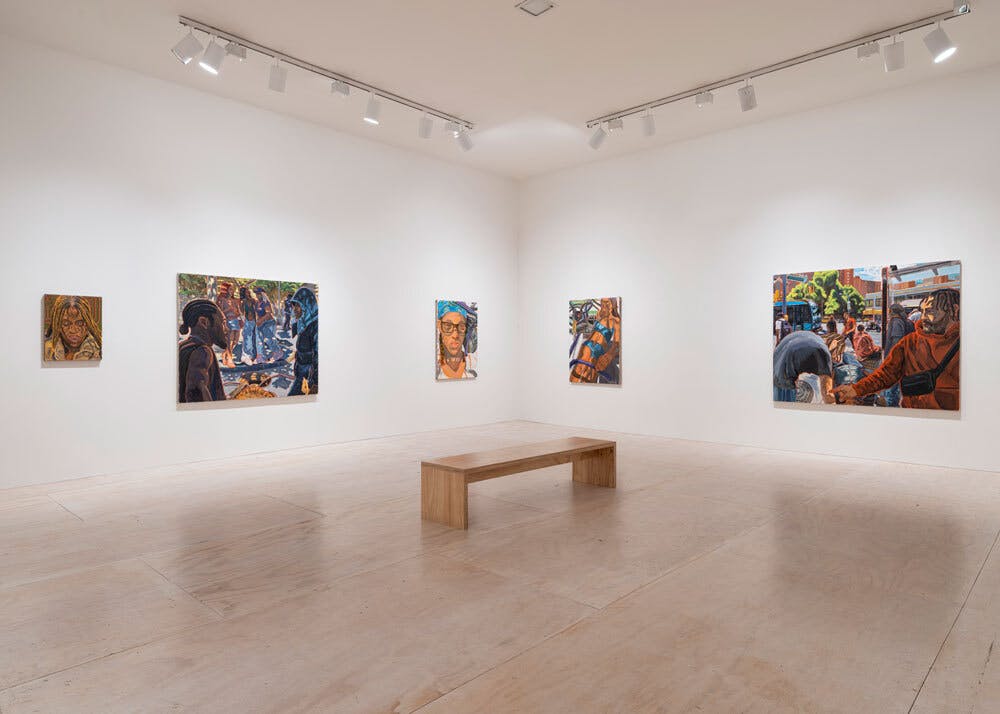See for Yourself


“Face flowed into her eyes. Flowed in soft cream foam and plaintive ripples, in such a way that wherever your glance may momentarily have rested, it immediately thereafter wavered in the direction of her eyes.” —Jean Toomer, Cane
I. Look Closely
The woman in Jacob Mason-Macklin's SpringPiston XC-gen-C (Khadijah's Dilemma) (2022) appears next to a cluster of purple and chrome machine parts. Wearing a patterned blue headscarf and brown glasses, she looks out past the picture frame at something viewers are not privy to. No, she isn’t meeting our gaze—rather, her honey-brown eyes look beyond us, a little to our right and over our shoulder, perhaps far off or maybe right behind. The painting conveys a sense of distance despite the intimate spatial relationship indicated by viewers’ proximity to the close-up rendition of the woman. Small details become our fascination in the face of inscrutability. The letters on her neck or the machinery to her left or the way her glasses cast a shadow on her cheeks and across the bridge of her nose all lead us to ask: Who is this woman? What is she looking at? Why are we looking at her?
Venturing into the interstices between what we observe of people and what we know of them, Mason-Macklin's work gives rise to more questions than it tries to answer. Rather than developing individual subjects, he makes composite figures, drawing from movies, fashion editorials, personal connections, and everyday observations to create figurative works that explore the sensation of looking rather than a one-to-one record. His are not sentimental portraits of loved ones or a documentarian’s take on a city and its people. His subjects are invented amalgamations that speak to what it felt like for the artist, and us, to look at someone, not to who that someone actually is.
When I spoke with Mason-Macklin in September 2022, he talked me through his practice, detailing his process and probing the ambiguities and tensions found within his work. “With this body of work, it has been very observation-based,” he said of the pieces he painted during his Studio Museum residency, continuing, “I spend a lot of my practice collecting images, but even before that (it does sound cliché) I start by looking.” For Mason-Macklin, this looking happens every day, whether watching the July sun bake the pavement in St. Nicholas Park or a shadow spotting the face of someone seeking refuge from that summer heat. With observation as a point of departure, Mason-Macklin's works during his Harlem residency naturally adopted an ethos distinct to the New York neighborhood. He elaborated on this further, explaining, “The lighting and the shadow uptown has been this inspiration for me. It’s sun-dappled and it’s intense, but there’s also an overwhelming beauty to it that can almost become unsettling.”
Linear and painterly moments abut in Mason-Macklin's paintings. Red outlines frame impressionistic swaths of color, imbuing the work with the buzzing heat of the city in summer as urban flora rises amid brick buildings and concrete sidewalks. He pays close attention to the interplays of light and shadow present in a single glance. That skin you think of as brown is actually blue, mauve, ochre, and pink. His paintings draw attention to the sensation of looking through their composition, in turn prompting a reckoning with the many complications bound up in that act.


II. Look Away
“Am I looking too long? Should I be looking? Why am I looking?”1 The woman in Mason-Macklin’s Solar Plexxus (2022) leans back, her denim shorts unbuttoned. Like the figure in SpringPiston XC-gen-C (Khadijah's Dilemma), this woman appears amid a tangle of machinery. Her outward glance and diagonal positioning guide our eyes to her warm-weather attire, bared midriff, and open fly. In this moment, the sensation of looking becomes instantly charged. Look long enough and the moment becomes disquieting. The glance becomes an intrusion, transforming from an observation of light and shadow to a breach of private space. Mason-Macklin is deliberate in generating this effect for viewers. Of the aforementioned questions that arise, both when viewing his work and encountering other people in our daily lives, he says, “That’s an important feeling to imbue into the painting itself—that it’s not always easy looking, but it is real, and it is purposeful. I try to mirror the process of looking as much as possible.”
In his works produced during his residency at the Studio Museum in Harlem, Mason-Macklin pays close attention to the ways looking is recast in the environment of Harlem. To him, New York offers a collapse of public and private space in which “you see different people next to each other constantly.”2 Thus, countless dynamics come into play when navigating the city. When people of all social strata exist alongside one another, a walk through the park becomes a navigation of positionality as the line between observation and surveillance shifts, dependent upon who is looking and who is being looked at. Acting in the same way as the infrastructure of State surveillance—from semispherical cameras atop traffic lights to the tens of thousands of unseen components that make up the NYPD’s Domain Awareness System—our eyes move hungrily across our surroundings, consuming and analyzing all they encounter.3 Only by asking ourselves questions like those Mason-Macklin presented do we become aware of the potential breaches of privacy that come with looking.
I spend a lot of my practice collecting images, but even before that (it does sound cliché) I start by looking


In NightRyde (2022) we see another woman, this time with her back turned, looking to her left. In front of her, two people sit on a motorcycle near an approaching bus, while behind her, a man seems to gesture in her direction. A cigarette sits tucked behind his ear as he extends his hand. While the gesture could be directed toward the nearby woman, that fact remains unclear to viewers. We just don’t know enough—too many ambiguities remain to determine much of anything. He could be looking toward her, but he could be focused elsewhere. Veiled in this ambiguity, the painting is a reminder of the limitations of looking. And that we need far more information to judge what we see.
Operating with a sense of distance from his subjects, Mason-Macklin creates a barrier for passing judgment upon those he depicts. Uninterested in contempt or adulation, his works reflect the gaps in what we can know about others from a single look, extending to his subjects the “grace in existing as you are without those extremes of needing to be noble, needing to be glorified, or needing to be pathologized.”4 Mason-Macklin's paintings prominently feature Black subjects, and in offering the grace of unburdened representation to these figures, he strikes a balance between the importance of visibility for Black people in visual art and the freedom to exist as they are, protected by a layer of removal from observers. By not narrativizing the subjects, he tries to steer clear of sentimentality and works toward what he called a state of "isness.”
III. Look Back
From Japanese ukiyo-e woodblock prints to R&B love songs, Mason-Macklin's well of influences runs deep. In our conversation, he mentioned Impressionists’ use of color, and cinematic framing techniques, but he lingered on his praise for Jean Toomer’s groundbreaking 1923 novel Cane.
Often cited as a foundational text of the Harlem Renaissance, Cane surges with the descriptive force of paint on canvas. Writing with richly textured visual detail, the author documented Black lives across rural Georgia and the urban North through vignettes punctuated by poems and other nonnarrative moments: "Her eyes, if it were sunset, rested idly where the sun, molten and glorious, was pouring down between the fringe of pines. Or maybe they gazed at the gray cabin on the knoll from which an evening folk-song was coming. Perhaps they followed a cow that had been turned loose to roam and feed on cotton-stalks and corn leaves … Wherever they looked, you’d follow them and then waver back. Like her face, the whole countryside seemed to flow into her eyes. Flowed into them with the soft listless cadence of Georgia’s South."5
Other vignettes exist alongside one another, sometimes intersecting, sometimes floating independently. Perhaps their subjects encountered one another in church or the grocery store, or maybe all they shared was a passing glance. Toomer’s poetic and experimental approach to storytelling sketched the contours of the everyday lives of many while maintaining a sense of space between the writer and his subjects. Relishing the small details, Cane employs looking and feeling as ways to recreate the emotional realities of Black people. Writing about Cane for The Crisis in 1924, author and sociologist W.E.B. Du Bois celebrated Toomer’s descriptive power, even in the face of his distaste for the ambiguity in some of the book’s vignettes and Toomer’s outsider perspective on Georgia. Linking Toomer’s writing to histories of visual art, Du Bois wrote, “He paints things that are true, not with Dutch exactness, but rather with an impressionist’s sweep of color.”6
Like Toomer, Mason-Macklin paints things that are true. No, wires and car parts don’t hover by people’s heads like vines, but our visual experience of city spaces is certainly molded by technology and infrastructure. No, the figures in his paintings are not exact, but they spring from the source material of Black cultural production and the artist’s lived experience, resulting in faces who feel familiar. We see cousins, friends, movie stars, and strangers brought to life in vivid color on his canvases. Also, like Toomer, who wrote Cane after just a short period of living in Georgia, Mason-Macklin approached this body of work as an outsider. Originally from Columbus, Ohio, the artist’s residency marked a formal introduction to life in Harlem—to the unique blend of greenery and machinery, the bustling heat of the glowing summertime city, and the resplendent hues of blackness in the storied neighborhood. As Toomer wrote with wonder about the Georgia dusk or wisps of fog shrouding a blood-red moon, so too does Mason-Macklin paint, approaching the people and places of uptown Manhattan with reverential care and nuance.
These Harlem works revel in the beauty and shortcomings of observation, moving beyond what we can see of others to reflect the many sensations, both troubling and exciting, that we and the artist alike feel while looking at the world around us.


NOTES
[1] Conversation with Jacob Mason-Macklin, September 6, 2022.
[2] Conversation with Jacob Mason-Macklin, September 6, 2022.
[3] Ali Watkins, “How the NYPD Is Using Post 9/11 Tools on Everyday New Yorkers,” New York Times, September 8, 2021, nytimes.com/2021/09/08/nyregion/nypd-9-11-police-surveillance.html
[4] Conversation with Jacob Mason-Macklin, September 6, 2022.
[5] Jean Toomer, Cane (New York: Liveright, 2011).
[6] W.E.B Du Bois, "The Younger Literary Movement," The Crisis 28 (Feb 1924): 162.